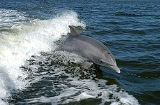
Dolphin
Overview
Dolphins are marine mammal
s that are closely related to whale
s and porpoise
s. There are almost forty species of dolphin in 17 genera
. They vary in size from 1.2 m (3.9 ft) and 40 kg (88.2 lb) (Maui's dolphin
), up to 9.5 m (31.2 ft) and 10 tonne (the orca or killer whale). They are found worldwide, mostly in the shallower seas of the continental shelves, and are carnivores, mostly eating fish
and squid
. The family
Delphinidae
is the largest in the Cetacea
n order, and evolved relatively recently, about ten million years ago, during the Miocene
.
Marine mammal
Marine mammals, which include seals, whales, dolphins, and walruses, form a diverse group of 128 species that rely on the ocean for their existence. They do not represent a distinct biological grouping, but rather are unified by their reliance on the marine environment for feeding. The level of...
s that are closely related to whale
Whale
Whale is the common name for various marine mammals of the order Cetacea. The term whale sometimes refers to all cetaceans, but more often it excludes dolphins and porpoises, which belong to suborder Odontoceti . This suborder also includes the sperm whale, killer whale, pilot whale, and beluga...
s and porpoise
Porpoise
Porpoises are small cetaceans of the family Phocoenidae; they are related to whales and dolphins. They are distinct from dolphins, although the word "porpoise" has been used to refer to any small dolphin, especially by sailors and fishermen...
s. There are almost forty species of dolphin in 17 genera
Genus
In biology, a genus is a low-level taxonomic rank used in the biological classification of living and fossil organisms, which is an example of definition by genus and differentia...
. They vary in size from 1.2 m (3.9 ft) and 40 kg (88.2 lb) (Maui's dolphin
Maui's dolphin
Maui's dolphin is the world's smallest known species of dolphin. They are a sub-species of the Hector's dolphin....
), up to 9.5 m (31.2 ft) and 10 tonne (the orca or killer whale). They are found worldwide, mostly in the shallower seas of the continental shelves, and are carnivores, mostly eating fish
Fish
Fish are a paraphyletic group of organisms that consist of all gill-bearing aquatic vertebrate animals that lack limbs with digits. Included in this definition are the living hagfish, lampreys, and cartilaginous and bony fish, as well as various extinct related groups...
and squid
Squid
Squid are cephalopods of the order Teuthida, which comprises around 300 species. Like all other cephalopods, squid have a distinct head, bilateral symmetry, a mantle, and arms. Squid, like cuttlefish, have eight arms arranged in pairs and two, usually longer, tentacles...
. The family
Family (biology)
In biological classification, family is* a taxonomic rank. Other well-known ranks are life, domain, kingdom, phylum, class, order, genus, and species, with family fitting between order and genus. As for the other well-known ranks, there is the option of an immediately lower rank, indicated by the...
Delphinidae
Oceanic dolphin
Oceanic dolphins are the members of the Delphinidae family of cetaceans. These marine mammals are related to whales and porpoises. They are found worldwide, mostly in the shallower seas of the continental shelves...
is the largest in the Cetacea
Cetacea
The order Cetacea includes the marine mammals commonly known as whales, dolphins, and porpoises. Cetus is Latin and is used in biological names to mean "whale"; its original meaning, "large sea animal", was more general. It comes from Ancient Greek , meaning "whale" or "any huge fish or sea...
n order, and evolved relatively recently, about ten million years ago, during the Miocene
Miocene
The Miocene is a geological epoch of the Neogene Period and extends from about . The Miocene was named by Sir Charles Lyell. Its name comes from the Greek words and and means "less recent" because it has 18% fewer modern sea invertebrates than the Pliocene. The Miocene follows the Oligocene...
.
Unanswered Questions

